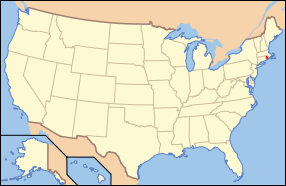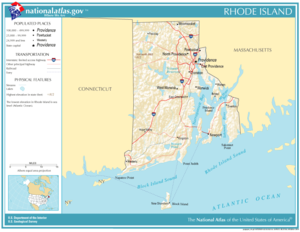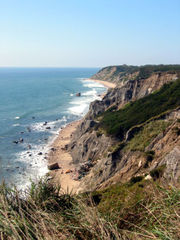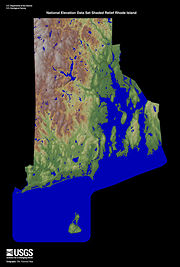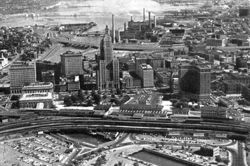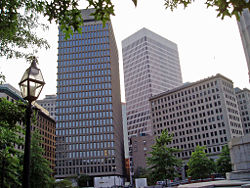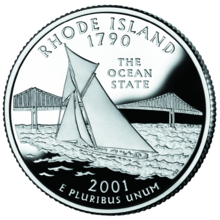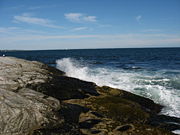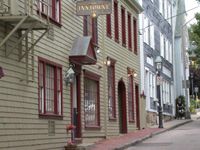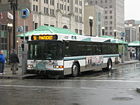Rhode Island
2008/9 Schools Wikipedia Selection. Related subjects: North American Geography
| Rhode Island and Providence Plantations | |||||||||||
|
|||||||||||
| Official language(s) | none (de facto English) | ||||||||||
| Demonym | Rhode Islander | ||||||||||
| Capital | Providence | ||||||||||
| Largest city | Providence | ||||||||||
| Area | Ranked 50th in the US | ||||||||||
| - Total | 1,545 sq mi (3,144 km²) |
||||||||||
| - Width | 37 miles (60 km) | ||||||||||
| - Length | 48 miles (77 km) | ||||||||||
| - % water | 32.4 | ||||||||||
| - Latitude | 41° 09' N to 42° 01' N | ||||||||||
| - Longitude | 71° 07' W to 71° 53' W | ||||||||||
| Population | Ranked 43rd in the US | ||||||||||
| - Total | 1,048,319 | ||||||||||
| - Density | 691.0/sq mi 387.35/km² (2nd in the US) |
||||||||||
| Elevation | |||||||||||
| - Highest point | Jerimoth Hill 812 ft (247 m) |
||||||||||
| - Mean | 200 ft (60 m) | ||||||||||
| - Lowest point | Atlantic Ocean 0 ft (0 m) |
||||||||||
| Admission to Union | May 29, 1790 (13th) | ||||||||||
| Governor | Donald Carcieri (R) | ||||||||||
| Lieutenant Governor | Elizabeth H. Roberts (D) | ||||||||||
| U.S. Senators | Jack Reed (D) Sheldon Whitehouse (D) |
||||||||||
| Congressional Delegation | List | ||||||||||
| Time zone | Eastern: UTC-5/ -4 | ||||||||||
| Abbreviations | RI US-RI | ||||||||||
| Website | www.ri.gov | ||||||||||
| Footnotes: * Total area in acres is approximately 776,957 acres (3,144 km²) |
|||||||||||
Rhode Island (IPA: /roʊd 'aɪlɪnd/), officially named the State of Rhode Island and Providence Plantations, is a state in the New England region of the United States. It is the smallest U.S. state by area.
The state is called Rhode Island in common usage, but most of the state lies on the North American mainland. Providence Plantations refers to the mainland, while Rhode Island is actually the official name for Aquidneck Island (now composed of the city of Newport, and the towns of Middletown and Portsmouth).
Having a history of staunch independence, Rhode Island was the first of the thirteen original American colonies to declare independence from British rule and the last to ratify the United States Constitution.
Rhode Island has long held the nickname of "Little Rhody", though the state has officially adopted the nickname of "the Ocean State," as nearly one tenth of Rhode Island's inland area is covered by salt water, and no part of the state is more than a 30-minute drive from the water's edge.
Name origin
In 1524, Italian navigator Giovanni da Verrazzano was the first European to visit any part of what is now Rhode Island. He came to what is now Block Island and named it "Luisa" after Louise of Savoy, Queen Mother of France. When the founders of the Colony of Rhode Island and Providence Plantations surveyed the land, they thought that Aquidneck Island was the place. A mistake occurred in 1614, when Luisa was charted by the Dutch explorer Adriaen Block, after whom Luisa was renamed by the Dutch West India Company; however, their motives in doing so are unknown. The official explanation by the State of Rhode Island is that Adriaen Block named the area "Roodt Eylandt" meaning "red island" in reference to the red clay that lined the shore, and that the name was later anglicized when the region came under British rule.
Geography
The smallest of the 50 states, Rhode Island covers an area of approximately 1,545 square miles (4,002 km²) and is bordered on the north and east by Massachusetts, on the west by Connecticut, and on the south by Rhode Island Sound and the Atlantic Ocean. It shares a water border with New York between Block Island and Long Island. The mean elevation of the state is 200 feet (60 m).
Nicknamed the Ocean State, Rhode Island is home to a number of oceanfront beaches. Rhode Island is mostly flat with no real mountains. Rhode Island's highest natural point is Jerimoth Hill, only 812 feet (247 m) above sea level.
Located within the New England province of the Appalachian Region, Rhode Island has two distinct natural regions. Eastern Rhode Island contains the lowlands of the Narragansett Bay, while Western Rhode Island forms part of the New England Upland. Narragansett Bay is a major feature of the state's topography. Block Island lies approximately 12 miles (19 km) off the southern coast of the mainland. Within the Bay, there are over 30 islands. The largest is Aquidneck Island, shared by the municipalities of Newport, Middletown, and Portsmouth. The second-largest island is Conanicut; the third-largest is Prudence.
A rare type of rock called Cumberlandite, found only in Rhode Island (specifically in the town of Cumberland), is the state rock. There were initially two known deposits of the mineral, but since it can be engineered into a form of gunpowder, one of the deposits was almost completely mined in the American Civil War.
Climate
Rhode Island is an example of a warm summer humid continental climate with hot, rainy summers and cold, snowy winters. The highest temperature recorded in Rhode Island was 105 ° F (40 ° C), recorded on August 2, 1975 in Providence. The lowest temperature in Rhode Island, -13 °F (-25 °C), was recorded on February 6, 1996 in Coventry. Monthly average temperatures range from a high of 82 °F (28 °C) to a low of 20 °F (-7 °C).
History
Colonial Era
In 1524, Italian navigator Giovanni de Verrazzano traversed the mid-Atlantic coast of North America, searching for an all-water route through North America to China. In March of that year, he left what is now New York Harbor and headed east until he discovered what was later called Block Island. Natives guided him into what is now Newport Harbour. He remained for two weeks while his crew surveyed the bay and the surrounding mainland. In early May 1524, Verrazzano departed to renew his search for a Northwest Passage.
In 1614, the Dutch explorer Adriaen Block visited the island that is now called Block Island. Native American inhabitants included the Narragansett tribe, occupying most of the area, and the closely related Niantic tribe. Most of the Native Americans were decimated by introduced diseases such as smallpox, intertribal warfare, and the disastrous King Philip's War, but remnants of the Niantic merged into the Narragansett tribe, where they remain on a federally recognized reservation.
In 1636, Roger Williams, after being banished from the Massachusetts Bay Colony for his religious views, settled at the tip of Narragansett Bay. He called the site Providence and declared it a place of religious freedom.
The following year, Anne Hutchinson was banished from Massachusetts for criticizing the clergy there. She and some others, including William Coddington and John Clark, founded the town of Portsmouth on Aquidneck Island. In 1639, Coddington left Portsmouth and founded Newport, also on Aquidneck Island.
In that same year, a formal government was established for the island. William Coddington was the first governor, and Philip Sherman was the first secretary. In 1643, Samuel Gorton founded Shawomet, which is now called Warwick. In 1644, the name of Aquidneck Island was changed to Rhode Island.
John Clarke was granted a Charter in 1663 for Rhode Island and Providence Plantations, which effectively united the two colonies into one. Under the terms of the charter, only landowners could vote. Before the Industrial Revolution, when most people were employed as farmers, this was considered democratic. The original charter was used as the state constitution until 1842.
The relationship between the New Englanders and the Native Americans was strained, and caused some bloodshed. On December 19, 1675, colonist militia from Connecticut, Massachusetts Bay, Plymouth, and Rhode Island massacred about 350 Narragansetts in the Battle of the Great Swamp during King Philip's War. The largest tribes that lived near Rhode Island were the Wampanoag, Pequots, Narragansett, and Nipmuck. One native named Squanto, from the Wampanoag tribe, stayed with the Pilgrims and taught them many valuable skills needed to survive in the area. He also helped greatly with the eventual peace between the colonists and the natives.
Roger Williams had kept the powerful Narragansetts on friendly terms with local white settlers. The Narragansetts were even persuaded to form an alliance with the English in 1637, carrying out an attack that nearly extinguished the Pequots. This peace did not last long, however, and by 1670, even the friendly tribes who had greeted Williams and the Pilgrims became estranged from the colonists, and conflicts erupted.
The most important and traumatic event in 17th century Rhode Island was King Philip's War, which occurred during 1675–1676. King Philip (also known as Metacomet) was the chief of the Wampanoag tribe. The settlers of Portsmouth had purchased their land from his father, Massasoit. King Philip rebelled against the English. The first attacks were around Narrangansett Bay, but spread throughout New England. The war culminated in Rhode Island in the Great Swamp Fight, where the colonial militia invaded and destroyed the Narragansett Indian village in the Great Swamp in southern Rhode Island, by Worden's Pond. Metacomet himself was eventually captured near Bristol, RI by agents working for Captain Benjamin Church. Metacomet was slain by his assailants.
Revolution and industrialization: 1770–1860
Rhode Island's tradition of independence and dissent gave it a prominent role in the American Revolution. In 1772, the first bloodshed of the American Revolution took place in Rhode Island when a band of Providence residents attacked a grounded British ship for enforcing unpopular British trade regulations. This incident would come to be known as the Gaspee Affair. Keeping with its culture of defiance, Rhode Island was the first of the original thirteen colonies to declare its independence from Great Britain ( May 4, 1776,) and the last to ratify the Constitution, doing the latter only after being threatened with having its exports taxed as a foreign nation. During the Revolution, Portsmouth was the site of the first African American military unit, the 1st Rhode Island Regiment, to fight for the U.S. in the Battle of Rhode Island.
As the Industrial Revolution moved large numbers of workers into the cities, a permanently landless, and therefore voteless, class developed. By 1829, 60% of the state's free white males were ineligible to vote.
Several attempts had been made to address this problem, but none were successful. In 1842, Thomas Dorr drafted a liberal constitution which was passed by popular referendum. However, the conservative sitting governor, Samuel Ward King, opposed the people's wishes, leading to the Dorr Rebellion. Although this was not a success, a modified version of the constitution was passed in November, which allowed any white male to vote if he owned land or could pay a $1 poll tax.
In addition to industrialization, Rhode Island was heavily involved in the slave trade during the post-revolution era. Slavery was extant in the state as early as 1652, and by 1774, the slave population of Rhode Island was 6.3%, nearly twice as high as any other New England colony. In the late 18th century, several Rhode Island merchant families began actively engaging in the triangle slave trade. Notable among these was the Brown family, for whom Brown University is named, although some Browns became prominent abolitionists. In the years after the Revolution, Rhode Island merchants controlled between 60% and 90% of the American trade in African slaves.
Civil War to Progressive Era: 1860–1929
During the Civil War, Rhode Island was the first Union state to send troops in response to President Lincoln's request for help from the states. Rhode Island furnished 25,236 fighting men, of whom 1,685 died. On the home front, Rhode Island, along with the other northern states, used its industrial capacity to supply the Union Army with the materials it needed to win the war. In addition, Newport was the temporary home of the United States Naval Academy during the war. Rhode Island's continued growth and modernization led to the creation of an urban mass transit system and improved health and sanitation programs. In 1866, Rhode Island abolished racial segregation throughout the state.
Post-war immigration increased the population. From the 1860s to the 1880s, most immigrants were from England, Ireland, Germany, Sweden, and Quebec. Toward the end of the century, however, most immigrants were from Eastern Europe and the Mediterranean. At the turn of the century, Rhode Island had a booming economy, which fed the demand for immigration. In the years leading up to World War I, Rhode Island's constitution remained reactionary, in contrast to the more progressive reforms that were occurring in the rest of the country. The state never ratified the 18th Amendment establishing national prohibition of alcohol. During World War I, Rhode Island furnished 28,817 troops, of whom 612 died. After the war, the state was hit hard by the Spanish Influenza. In the 1920s and 1930s, rural Rhode Island saw a surge in Ku Klux Klan membership, largely in reaction to the large waves of immigrants moving to the state. The Klan is believed to be responsible for burning the Watchman Industrial School in Scituate, which was a school for African American children.
Great Depression to present: 1929-
In the 20th century, the state continued to grow, though the decline in industry devastated many urban areas. These areas were impacted further, as with the rest of the country's urban areas, by construction of Interstate highways through city cores and the suburbanization caused by it and by the GI Bill.
Since the Great Depression, the Rhode Island Democratic Party has dominated local politics. The Democratic Party's core of support is in the urban areas of the state. While known for old school politics and corruption, Rhode Island also has comprehensive health insurance for low-income children, and a large social safety net. Despite this, many urban areas still have a high rate of children in poverty. Due to an influx of residents from Boston, increasing housing costs have resulted in more homeless in Rhode Island.
The Republican Party, virtually non-existent in the state legislature, has successfully put forward occasional state-wide "good government" reform candidates who criticize the state's high taxes and the excesses of the Democratic Party. Current Governor Donald Carcieri of East Greenwich, and former Mayor Vincent A. "Buddy" Cianci of Providence (who later became an independent political boss, and was convicted on RICO charges) ran as Republican reform candidates.
Prominent Democrats include House Speaker William Murphy, Senate President Joseph Montalbano, Providence Mayor David Cicilline, Secretary of State A. Ralph Mollis, General Treasurer Frank Caprio, Senate Majority Leader M. Teresa Paiva-Weed, and Lt. Gov. Elizabeth Roberts. In recent years, former Speaker of the House John Harwood, State Senator John Celona, and State Senate President William Irons were forced to resign amid scandals.
In 2003, a nightclub fire in West Warwick claimed one hundred lives and caught national attention. The fire resulted in criminal sentences.
Law and government
The capital of Rhode Island is Providence. The state's current governor is Donald L. Carcieri (R), and its United States Senators are Jack Reed (D) and Sheldon Whitehouse (D). Rhode Island's two United States Congressmen are Patrick J. Kennedy (D-1) and Jim Langevin (D-2). See congressional districts map.
Rhode Island is one of a few states that does not have an official Governor's residence. See List of Rhode Island Governors.
The state legislature is the Rhode Island General Assembly, consisting of the 75-member House of Representatives and the 38-member Senate. Both houses of the bicameral body are currently dominated by the Democratic Party.
Because Rhode Island's population barely crosses the threshold for additional votes in both the federal House and electoral college, it is well represented relative to its population, with the eighth-highest number of electoral votes and second-highest number of House Representatives per resident.
Federally, Rhode Island is one of the most reliably Democratic states during presidential elections, regularly giving the Democratic nominees one of their best showings. In 1980, Rhode Island was one of only 6 states to vote against Ronald Reagan. Reagan did carry Rhode Island in his 49-state victory in 1984, but the state was the second weakest of the states Reagan won. Rhode Island was the Democrats' leading state in 1988 and 2000, and second-best in 1996 and 2004. The state was devoted to Republicans until 1908, but has only strayed from the Democrats 7 times in the 24 elections that have followed. In 2004, Rhode Island gave John Kerry more than a 20-percentage-point margin of victory (the third-highest of any state), with 59.4% of its vote. All but three of Rhode Island's 39 cities and towns voted for the Democratic candidate. The only exceptions were East Greenwich, West Greenwich and Scituate.
Rhode Island has abolished capital punishment, making it one of 15 states that have done so. Rhode Island abolished the death penalty very early, just after Michigan (the first state to abolish it), and carried out its last execution in the 1840s. Rhode Island is one of two states in which prostitution is legal, provided it takes place indoors, though there have been recent efforts to change this.
Rhode Island has some of the highest taxes in the country, particularly its property taxes, ranking seventh in local and state taxes, and sixth in real estate taxes.
Economy
The Blackstone River Valley is known as the "Birthplace of the American Industrial Revolution". It was in Pawtucket that Samuel Slater set up Slater Mill in 1793, using the waterpower of the Blackstone River to power his cotton mill. For a while, Rhode Island was one of the leaders in textiles. However, with the Great Depression, most textile factories relocated to the American South. The textile industry still constitutes a part of the Rhode Island economy, but does not have the same power that it once had. Other important industries in Rhode Island's past included toolmaking, costume jewelry and silverware. An interesting by-product of Rhode Island's industrial history is the amount of abandoned factories - many of them now being used for low-income or elderly housing, or converted into offices or condominiums. Today, much of the economy of state is based in services, particularly healthcare and education, and still to some extent, manufacturing.
The headquarters of Citizens Financial Group, a 160 billion dollar banking corporation which operates in many parts of the US, is located in Providence. The Fortune 500 companies CVS and Textron are based in Woonsocket and Providence, respectively. FM Global, Hasbro, American Power Conversion, Nortek, and Amica Mutual Insurance are all Fortune 1000 companies based in Rhode Island. The GTECH Corporation is headquartered in Providence.
Rhode Island's 2000 total gross state product was $33 billion, placing it 45th in the nation. Its 2000 per capita personal income was $29,685, 16th in the nation. Rhode Island has the lowest level of energy consumption per capita of any state.
Health services are Rhode Island's largest industry. Second is tourism, supporting 39,000 jobs, with tourism-related sales at $3.26 billion in the year 2000. The third-largest industry is manufacturing. Its industrial outputs are fashion jewelry, fabricated metal products, electrical equipment, machinery, shipbuilding and boatbuilding. Rhode Island's agricultural outputs are nursery stock, vegetables, dairy products and eggs.
The state's taxes are appreciably higher than neighboring states. Governor Carcieri has claimed that this higher tax rate has had an inhibitory effect on business growth in the state and is calling for reductions to increase the competitiveness of the state's business environment. Rhode Island's income tax is based on 25% of the payer's federal income tax payment.
Demographics
| Historical populations | |||
|---|---|---|---|
| Census | Pop. | %± | |
| 1790 | 68,825 |
|
|
| 1800 | 69,122 | 0.4% | |
| 1810 | 76,931 | 11.3% | |
| 1820 | 83,059 | 8% | |
| 1830 | 97,199 | 17% | |
| 1840 | 108,830 | 12% | |
| 1850 | 147,545 | 35.6% | |
| 1860 | 174,620 | 18.4% | |
| 1870 | 217,353 | 24.5% | |
| 1880 | 276,531 | 27.2% | |
| 1890 | 345,506 | 24.9% | |
| 1900 | 428,556 | 24% | |
| 1910 | 542,610 | 26.6% | |
| 1920 | 604,397 | 11.4% | |
| 1930 | 687,497 | 13.7% | |
| 1940 | 713,346 | 3.8% | |
| 1950 | 791,896 | 11% | |
| 1960 | 859,488 | 8.5% | |
| 1970 | 946,725 | 10.1% | |
| 1980 | 947,154 | 0% | |
| 1990 | 1,003,464 | 5.9% | |
| 2000 | 1,048,319 | 4.5% | |
| Est. 2007 | 1,057,832 | 0.9% | |
| Demographics of Rhode Island (csv) | |||||
|---|---|---|---|---|---|
| By race | White | Black | AIAN* | Asian | NHPI* |
| 2000 (total population) | 90.96% | 6.45% | 1.07% | 2.74% | 0.19% |
| 2000 (Hispanic only) | 7.14% | 1.42% | 0.18% | 0.08% | 0.07% |
| 2005 (total population) | 90.16% | 7.07% | 1.09% | 3.07% | 0.21% |
| 2005 (Hispanic only) | 9.12% | 1.49% | 0.22% | 0.08% | 0.08% |
| Growth 2000–05 (total population) | 1.76% | 12.52% | 4.91% | 15.09% | 9.93% |
| Growth 2000–05 (non-Hispanic only) | -0.75% | 13.80% | 1.03% | 15.44% | 8.90% |
| Growth 2000–05 (Hispanic only) | 31.21% | 7.98% | 24.03% | 3.78% | 11.64% |
| * AIAN is American Indian or Alaskan Native; NHPI is Native Hawaiian or Pacific Islander | |||||
The centre of population of Rhode Island is located in Providence County, in the city of Cranston. A corridor of population can be seen from the Providence area, stretching northwest following the Blackstone River to Woonsocket, where nineteenth-century mills drive industry and development. According to the U.S. Census Bureau, as of 2005, Rhode Island had an estimated population of 1,076,189, which is a decrease of 3,727, or 0.3%, from the prior year and an increase of 27,870, or 2.7%, since the year 2000. This includes a natural increase since the last census of 15,220 people (that is 66,973 births minus 51,753 deaths) and an increase due to net migration of 14,001 people into the state. Immigration from outside the United States resulted in a net increase of 18,965 people, and migration within the country produced a net decrease of 4,964 people.
The six largest ancestry groups in Rhode Island are: Italian (19%), Irish (19%), French Canadian (17.3%), English (12%), Hispanic 11% (predominantly Puerto Rican and Dominican, with smaller Central American populations), Portuguese (8.7%).
According to the 2000 U.S. Census, 8.07% of the population aged 5 and over speaks Spanish at home, while 3.80% speaks Portuguese, 1.96% French, and 1.39% Italian .
6.1% of Rhode Island's population were reported as under 5, 23.6% under 18, and 14.5% were 65 or older. Females made up approximately 52% of the population.
Rhode Island has a higher percentage of Americans of Portuguese ancestry (who dominate Bristol County), including Portuguese Americans and Cape Verdean Americans than any other state in the nation. French Canadians form a large part of northern Providence County whereas Irish Americans have a strong presence in Newport and Kent counties. Yankees of English ancestry still have a presence in the state as well, especially in Washington county, and are often referred to as " Swamp Yankees."
Religion
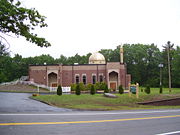
The religious affiliations of the people of Rhode Island are:
- Christian – 87.5%
- Roman Catholic – 63.6%,
- Protestant – 21.6%
- Baptist – 6.3%
- Episcopalian – 5.1%
- Protestant - other – 3.2%,
- Protestant, no denomination – 7%,
- Other Christian – 2.3%
- Jewish – 1.6%,
- Muslim – 0.4%
- Self-identified non-religious – 6%,
- Other religious – 4.5%;.
Episcopal Diocese of Rhode Island.
Rhode Island has the highest percentage of Roman Catholics in the nation mainly due to large Irish, Italian, and French Canadian immigration in the past (these 3 groups form roughly 55-60% of the state population); recently, significant Portuguese (though Portuguese communities have existed since the mid 19th century) and Hispanic communities (these 2 groups form roughly 20% of the state population) have also been established in the state. Though it has the highest overall Catholic percentage of any state, none of Rhode Island's individual counties ranks among the ten most Catholic in the United States, as Catholics are very evenly spread throughout the state. Rhode Island and Utah are the only two states in which a majority of the population are members of a single religious body.
Culture
Many Rhode Islanders speak with a non-rhotic accent that many compare to a "Brooklyn" or a cross between a New York and Boston accent ("water" becomes "wata"). Many Rhode Islanders pronounce the 'aw' sound as one might hear in New Jersey; e.g., "coffee" is pronounced "cauwwefee."
Nicknamed "The Ocean State, the nautical nature of Rhode Island's geography pervades its culture. Newport Harbour, in particular, holds many pleasure boats. In the lobby of the state's main airport, T. F. Green, is a large lifesize sailboat, and the state's license plates depict an ocean wave.
Additionally, the large number of beaches in Washington County (known locally as South County) lures many Rhode Islanders south for summer vacation.
The Fox show Family Guy takes place in a fictional town in Rhode Island named Quahog (the name of a large clam popular in Rhode Island), a satirised example of a small town in Rhode Island.
The state was notorious for organized crime activity from the 1950s into the 1990s when the Patriarca crime family held sway over most of New England from its Providence headquarters. Although the power of organized crime has greatly diminished in Rhode Island over the last 20 years, its residents are still stigmatized by popular perceptions of rampant graft and corruption that have haunted the state for decades.
Rhode Islanders developed a unique style of architecture in the 17th century, called the stone-ender.
Rhode Island is the only state to still celebrate Victory over Japan Day. It is known locally as "VJ Day", or simply "Victory Day".
Food
Rhode Island is a large per capita consumer of coffee. According to a Providence Journal article, the state features the highest number of coffee/donut shops per capita in the country, with over 225 Dunkin' Donuts locations in the state alone. The Official State Drink of Rhode Island is coffee milk, a beverage created by mixing milk with coffee syrup. This unique syrup was invented in the state and is bottled and sold in most Rhode Island supermarkets. Although coffee milk contains some caffeine, it is sold in school cafeterias throughout the state. Strawberry milk is also popular. Iced coffee is popular in both summer and winter. Frozen lemonade, a mixture of ice-slush, lemons and sugar is popular in the summer, especially Del's Frozen Lemonade, a company based in Cranston.
Several foods and dishes are unique to Rhode Island, and are hard to find outside of the state. " Hot Wieners," which are sometimes called "gaggers" or "weenies" are smaller than a standard hot dog but are covered in a meat sauce, chopped onions, mustard, and celery salt. Submarine sandwiches are referred to as "grinders" in Rhode Island, with a popular version being the Italian grinder, which is made with Italian cold cuts (usually ham, prosciutto, capicola, salami, and Provolone cheese). Chouriço (a spicy Portuguese sausage) and peppers, eaten with hearty bread, is also popular among the state's large Portuguese community. Another popular item is pizza strips. Sold in most supermarkets, they are rectangular strips of pizza without the cheese, and are often served cold. Spinach pies, similar to a calzone but filled with seasoned spinach instead of meat, sauce and cheese, are sold in many Italian bakeries and local supermarkets. Variations can include black olives or pepperoni with the spinach, or broccoli instead of spinach.
The state is also known for its jonnycakes. As in colonial times, johnny cakes are made with corn meal and water, and pan fried much like pancakes. During fairs and carnivals, Rhode Islanders enjoy dough boys, plate-sized disks of deep fried dough sprinkled with cinnamon and sugar. While these are known as zeppolas in other states, such as New York, in Rhode Island zeppolas or zeppolis are completely different. Traditionally eaten on Saint Joseph's Day (widely celebrated across the state), St. Joseph's Day zeppolis are doughnut-like pastries with exposed centers of vanilla pudding or riccota cream, topped with a cherry.
The Ocean State's tradition has a strong tradition of seafood. Shellfish is extremely popular, with clams being used in multiple ways. Taken from the Narragansett "Poquauhock" (see "A Key into the Language of America" by Roger Williams 1643)"Quahaug" is a more correct spelling for this popular shellfish. The quahog (whose shell is Rhode Island's state shell) is a large clam which is mixed with stuffing and spicy minced sausage and then baked in the shell to form a "Stuffie." Steamed clams are also a very popular dish. Fried squid, or "calamari," is most popular in Italian restaurants, typically served Sicilian-style: tossed with spicy banana peppers and with marinara sauce on the side.
Rhode Island, like the rest of New England, has a long tradition of clam chowder. While the white "New England" variety is popular and the red "Manhattan" variety is not uncommon, Rhode Island makes a clear chowder, known as "Rhode Island Clam Chowder."
Perhaps the most unusual culinary tradition in Rhode Island is the " clam cake." The clam cake (also known as a fritter) is a deep fried ball of buttery dough with chopped bits of clam inside. They are sold by the half-dozen or dozen in most seafood restaurants around the state. The quintessential summer meal in Rhode Island is "clam cakes and chowder."
It is also said that Clams Casino originated in Rhode Island after being "invented" by Julius Keller, the maitre d' in the original Casino next to the seaside Towers in Narragansett. Clams Casino resemble the beloved stuffed quahog but are generally made with the smaller littleneck or cherrystone clam and are unique in their use of bacon as a topping.
Sports
- Pawtucket Red Sox, AAA (minor league baseball) affiliate of the Boston Red Sox
- Providence Bruins, AHL (minor league hockey) affiliate of the Boston Bruins
- Newport Gulls, NECBL (New England Collegiate Baseball League)
- Rhode Island Stingrays, USL PDL minor league soccer team
- Rhode Island Rams*, Division 1 NCAA Basketball Team of the University of Rhode Island
- Brown University Bears, Division 1 NCAA Basketball Team
- Providence Friars, Division 1 NCAA Basketball Team of Providence College
- Bryant Bulldogs, Division 2 NCAA Basketball Team of Bryant University
The Providence Grays won the first World Championship in baseball history in 1884. The team played their home games at the old Messer Street Field in Providence. The Grays played in the National League from 1878 to 1885. They defeated the New York Metropolitans of the American Association in a best of five game series at the Polo Grounds in New York. Providence won three straight games to become the first champions in major league baseball history.
Babe Ruth played for the minor league Providence Grays of 1914 and hit his only official minor league home run for that team before being recalled by the Grays parent club, the Boston Red Stockings.
A now defunct professional football team, the Providence Steam Roller won the 1928 NFL title. They used to play in a 10,000 person stadium called the Cycledrome. A team by a similar name, the Providence Steamrollers, played in the Basketball Association of America, which would become the National Basketball Association.
From 1930 to 1983, America's Cup races were sailed off Newport, and the first few extreme-sport X Games and Gravity Games were hosted in the state's capital city.
Landmarks
The state capitol building is made of white Georgian marble. On top is the world's fourth largest self-supported marble dome. It houses the Rhode Island Charter of 1663 and other state treasures.
Providence is home to the First Baptist Church in America, the oldest Baptist church in the Americas, which was founded by Roger Williams in 1638. Providence is the home of the first fully automated post office in the country. The seaside city of Newport is home to many famous mansions, including The Breakers, Marble House and Belcourt Castle. It is also home to the Touro Synagogue, dedicated on 2 December 1763, considered by locals to be the first synagogue within the United States (see below for information on New York City's contestant), and still serving. The synagogue showcases the religious freedoms that were established by Roger Williams as well as impressive architecture in a mix of the classic colonial and Sephardic style. The Newport Casino is a National Historic Landmark building complex that presently houses the International Tennis Hall of Fame and features an active grass-court tennis club.
Rhode Island is home to the famous roadside attraction Nibbles Woodaway, the Big Blue Bug, the world's largest termite.
Fort Adams, on Narragansett Bay, was the setting for the finish of Eco-Challenge 1995.
Scenic Route 1A (known locally as Ocean Road) in Narragansett is home to "The Towers", a large stone arch. It was once the entrance to the famous Narragansett casino that burned down in 1900. The towers now serve as a tourist information centre and also a banquet hall for events like weddings and birthday parties.
Famous Rhode Islanders
Popular culture
The state of Rhode Island is often depicted in popular culture, partly due to its natives the Farrelly brothers and former resident and creator of the television show Family Guy, Seth MacFarlane.
Famous firsts in Rhode Island
- Rhode Island enacted the first law prohibiting slavery in North America on May 18, 1652.
- Slater Mill in Pawtucket was the first commercially successful cotton-spinning mill with a fully mechanized power system in America and was the birth place of the Industrial Revolution.
- The oldest Fourth of July Parade in the country is still held annually in Bristol, RI.
- The first Baptist Church in America was founded in Providence in 1638.
- Ann Smith Franklin of the Newport Mercury was the first woman newspaper editor in America ( August 22, 1762). She was the editor of "The Newport Mercury" in Newport, Rhode Island.
- Touro Synagogue, the first synagogue in America, was founded in Newport in 1763. Other sources say the first synagogue was the Mill Street, now South William Street, Synagogue in New York City, built by the Shearith Israel congregation in 1729 (or 1730), having earlier met in rented quarters, making Touro Synagogue the second-oldest in the United States.
- The first armed act of rebellion in America against the British Crown was the boarding and burning of the Revenue Schooner Gaspee in Narragansett Bay on June 10, 1772.
- The idea of a Continental Congress was first proposed at a town meeting in Providence on May 17, 1774. Rhode Island elected the first delegates ( Stephen Hopkins and Samuel Ward) to the Continental Congress on June 15, 1774.
- The Rhode Island General Assembly created the first standing army in the colonies (1,500 men) on April 22, 1775.
- On June 15, 1775, the first naval engagement of the American Revolution occurred between a Colonial Sloop commanded by Capt. Abraham Whipple and an armed tender of the British Frigate Rose. The tender was chased aground and captured. Later in June, the General Assembly created the first American Navy when it commissioned the Sloops Katy and Washington, armed with 24 guns and commanded by Abraham Whipple, who was promoted to Commodore.
- Rhode Island was the first Colony to declare independence from Britain on May 4, 1776.
- Pelham Street in Newport was the first in America to be illuminated by gaslight in 1806.
- The first strike in the United States in which women participated occurred in Pawtucket in 1824.
- Watch Hill has the nation’s oldest carousel that has been in continuous operation since 1850.
- The motion picture machine (a machine showing animated pictures) was patented in Providence on April 23, 1867.
- The first lunch wagon in America was introduced in Providence in 1872.
- The first nine hole golf course in America was completed in Newport in 1890.
- The first state health laboratory was established in Providence on September 1, 1894
- The Rhode Island State House was the first building with an all- marble dome to be built in the United States (1895–1901)
- The first automobile race on a track was held in Cranston on September 7, 1896.
- The first automobile parade was held in Newport on September 7, 1899 on the grounds of Belcourt Castle.
- The first NFL night game was held on November 6, 1929 at Providence's Kinsley Park. The Chicago (now Arizona) Cardinals defeated the Providence Steam Roller 16-0.
Cities and towns
There are 39 cities and towns in Rhode Island. Major population centers today result from historical factors — with the advent of the water-powered mill development took place predominantly along the Blackstone, Seekonk, and Providence Rivers.
Ranked by population, the state's 8 cities are:
- Providence (175,255)
- Warwick (87,233)
- Cranston (79,269)
- Pawtucket (73,742)
- East Providence (49,515)
- Woonsocket (44,328)
- Newport (26,475)
- Central Falls (19,159)
In common with many other New England states, some Rhode Island cities and towns are further partitioned into villages that reflect historic townships which were later combined for administrative purposes. Notable villages include Kingston, in the town of South Kingstown, which houses the University of Rhode Island, and Wickford, in North Kingstown, the site of an annual international art festival.
Education
Primary and secondary schools
Colleges and universities
Rhode Island has 14 colleges and universities:
- Brown University
- Bryant University
- Community College of Rhode Island
- Gibbs College
- Johnson & Wales University
- Naval War College
- New England Institute of Technology
- Providence College
- Rhode Island College
- Rhode Island School of Design
- Roger Williams University
- Salve Regina University
- University of Rhode Island
- Zion Bible College
Transportation
The Rhode Island Public Transit Authority (RIPTA), which has its hub in downtown Providence manages local bus transit for the state, serving 38 out of 39 Rhode Island communities. RIPTA has 58 bus lines, 2 tourist trolley lines known as LINK, and a seasonal ferry to Newport. The southern terminus of the MBTA commuter rail Providence/Stoughton Line is also in downtown Providence and connects to Boston. Ferry services link Block Island, Prudence Island, and Hog Island to the Rhode Island mainland.
The major airport is T. F. Green Airport in Warwick, though Logan International Airport in Boston is also used. The commuter rail is in the process of being extended to the airport, which will link by rail T.F. Green to Providence and Boston.
Interstate 95 runs diagonally across the state connecting major population centers, while the auxiliary interstate 295 provides a bypass around Providence. Narragansett Bay has a number of suspension bridge crossings connecting Aquidneck Island and Conanicut Island to the mainland, most notably the Claiborne Pell Newport Bridge and the Jamestown-Verrazano Bridge.
State symbols
State symbols include:
- State bird - " Rhode Island Red,"
- State flower - " Violet,"
- State tree - " Red Maple,"
- State drink - " Coffee Milk,"


